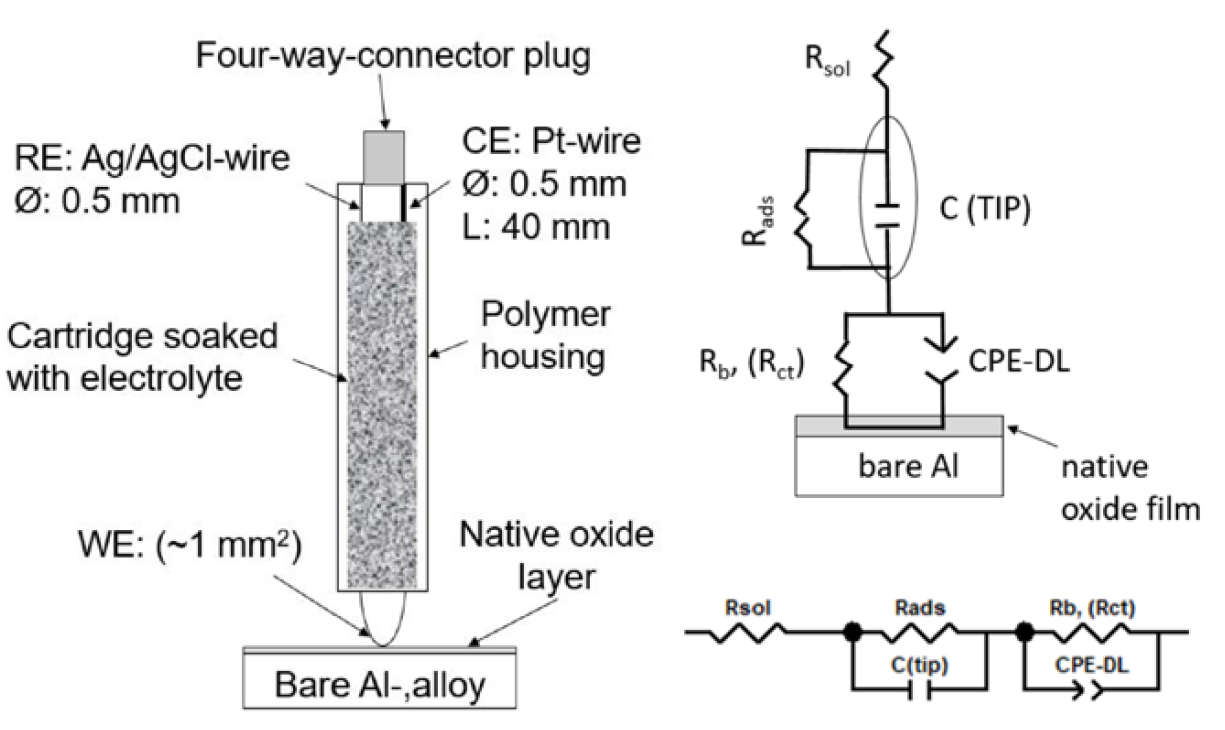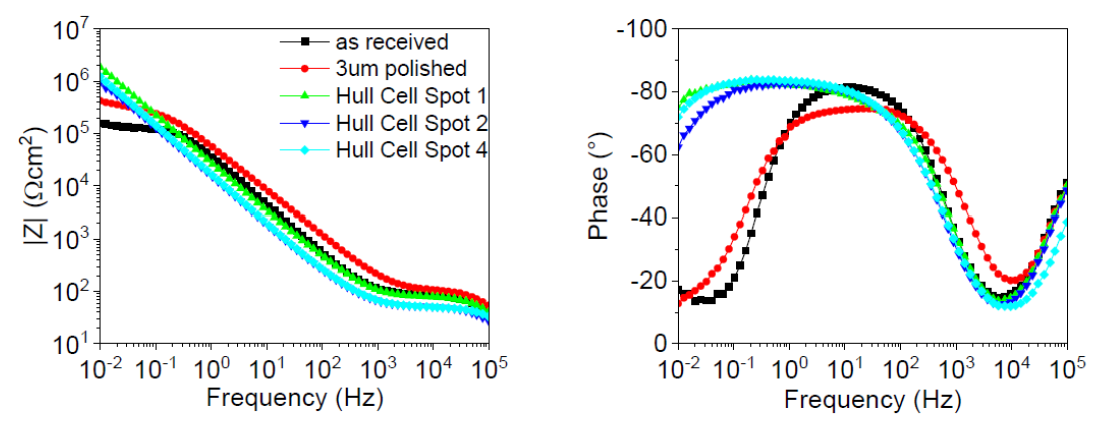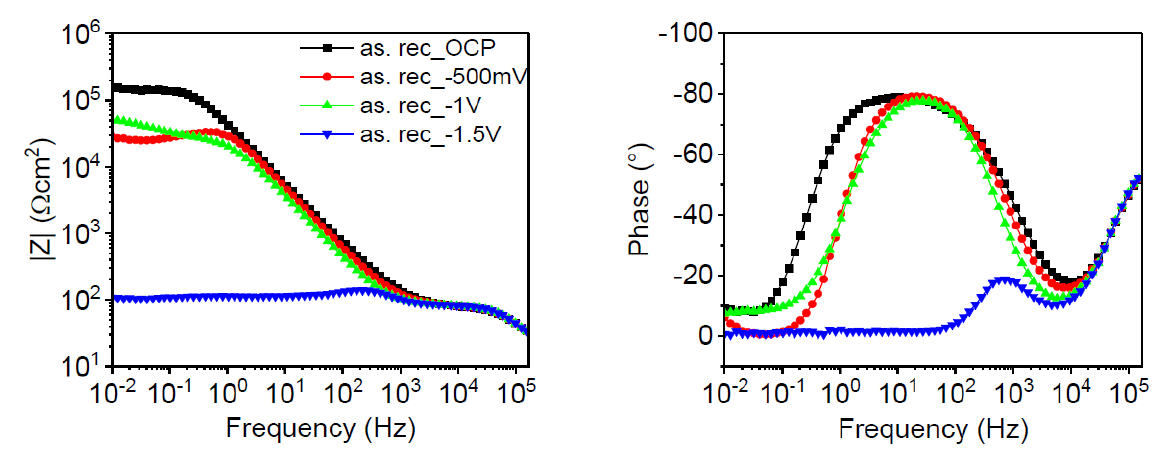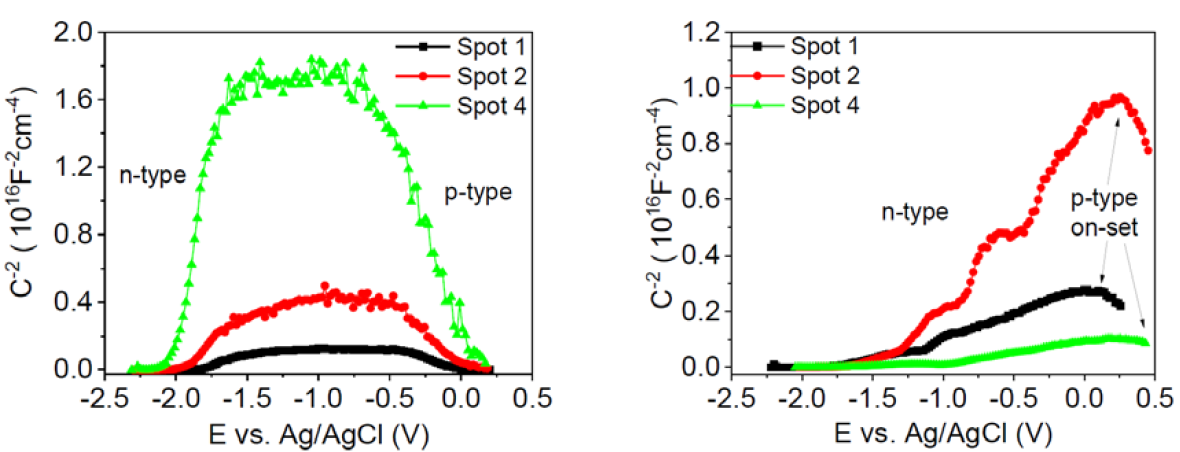英国曼彻斯特大学Dirk Engelberg 教授团队近期发表了《A Novel Approach to Determine Cathodic Passivation Characteristics and Semiconducting Properties of Pure Aluminium 99.5 wt. % and Aluminium Alloy 7075-T6 with an Electrochemical Pen Electrode》
在大范围内进性交流阻抗EIS测试时,独立的半电池反应会都会改变整个测试区域的阻抗响应,从而难以区分腐蚀系统的主动和被动区域。从1980年开始Isaacs教授引入了局部阻抗测试(localised electrochemical impedance spectroscopy,LEIS)[1,2]。随着科技的发展出现了扫描电化学显微镜(scanning electrochemical microscopy,SECM)和扫描电化学池显微镜(scanning electrochemical cell microscopy,SECCM),但这些技术是基于实验室的且繁琐,在数据采集过程中需要经验丰富的用户。而工程表面的电化学测量通常需要作为一种质量控制工具,并在众多技术应用中用于多种现场评估,以评估材料的抗腐蚀性能。IPS爱谱斯的电化学腐蚀测试笔(EC-PEN)通过提供毫米级别的测定来确定关键的电化学参数。例如,使用 EC-PEN电化学腐蚀测试笔进行研究以确定不同钢表面的开路电位和点蚀敏感性[3]、在焊缝改性区域检查激光束焊接的 Al-Zn-Mg-Cu 合金[4]。EC-PEN电化学腐蚀测试笔的局部阻抗测试允许在有限范围内非破坏性研究样品表面特性,以指示在暴露于腐蚀环境的表面旁边具有较低钝化强度的区域。EC-PEN电化学腐蚀测试笔还允许访问表面层和开发的表面薄膜的半导体特性,为局部现场表征和质量控制提供强大的工具。
英国曼彻斯特大学Dirk Engelberg 教授团队使用EC-PEN电化学腐蚀测试笔评估了纯铝 99.5 wt 和7075-T6铝合金的局部表面特性和相关的腐蚀性能。控制施加阴极极化梯度以沿合金面板表面产生不同的表面氧化物。在三个特定位置用EC-PEN电化学腐蚀测试笔进行开路电位下的局部电化学阻抗谱 (LEIS),然后进行莫特-肖特基 (M-S) 分析以确定每个位点的半导体行为。此外,还获得了逐步增加的阴极电位下的电化学阻抗性能,以评估工程合金在氢暴露过程中的表面降解机制。
Electrochemical pen electrode model

LEIS measurement under OCP-control

LEIS measurements under cathodically applied potentials

Mott-Schottky analysis of Hull-Cell spots from the cathodic panel

[1] H. S. Isaacs and M. W. Kendig, “Determination of Surface Inhomogeneities Using a Scanning Probe Impedance Technique,” Corrosion, vol. 36, no. 6, pp. 269–274, Jun. 1980,
doi: 10.5006/0010-9312-36.6.269
[2] R. S. Lillard, P. J. Moran, and H. S. Isaacs, “A Novel Method for Generating Quantitative Local Electrochemical Impedance Spectroscopy,” J. Electrochem. Soc., vol. 139, no. 4, p
p. 1007–1012, 1992, ” pp. 1–11
doi: 10.1149/1.2069332. industrial application
[3] M. Stefanoni, U. Angst, and B. Elsener, “Local electrochemistry of reinforcement steel - Distribution of open circuit and pitting potentials on steels with different surface condit
ion,” Corros. Sci., vol. 98, pp. 610–618, 2015,
doi: 10.1016/j.corsci.2015.06.004
[4] J. Wloka, T. Hack, and S. Virtanen, “Local electrochemical properties of laser beam-welded high-strength Al-Zn-Mg-Cu alloys,” Mater. Corros., vol. 59, no. 1, pp. 5–13, 2008,
doi: 10.1002/maco.200704081